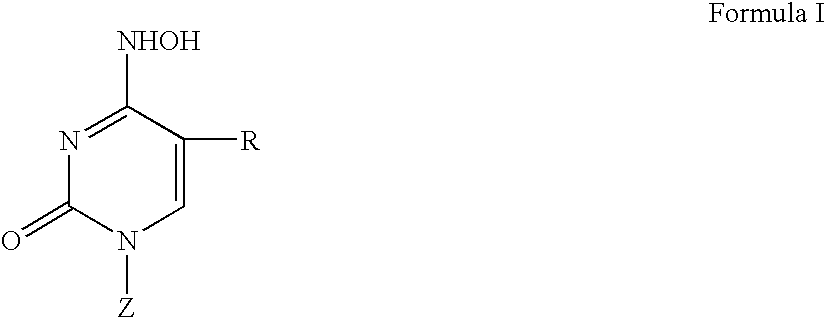[0094]In another particularly preferred embodiment of the invention the compounds of the invention, i.e., the
nucleoside, the
nucleic acid, the pharmaceutical agent, the vector, the cells and / or
organism, are used in a
single administration of from 1 to 80, especially from 3 to 30 mg / kg
body weight. In the same way as the total amount per day, the amount of a single
dose per application can be varied by a person of
specialized knowledge in the art. Similarly, the compounds used according to the invention can be employed in
veterinary medicine with the above-mentioned single concentrations and formulations together with the feed or feed formulations or drinking water. A single
dose preferably includes that amount of active substance which is administered in one application and which normally corresponds to one whole, one half daily
dose or one third or one quarter of a daily dose. Accordingly, the dosage units may preferably include 1, 2, 3 or 4 or more single doses or 0.5, 0.3 or 0.25 single doses. In a preferred fashion, the daily dose of the compounds according to the invention is distributed over 2 to 10 applications, preferably 2 to 7, and more preferably 3 to 5 applications. Of course,
continuous infusion of the agents according to the invention is also possible.
[0095]In a particularly preferred embodiment of the invention, 1 to 2 tablets are administered in each
oral application of the compounds of the invention. The tablets according to the invention can be provided with coatings and envelopes well-known to those skilled in the art or can be composed in a way so as to release the active substance (s) only in preferred, particular regions of the host.
[0096]In another preferred embodiment of the invention the compounds according to the invention can be employed together with at least one other well-known pharmaceutical agent. That is to say, the compounds of the invention can be used in a prophylactic or therapeutic combination in connection with well-known drugs. Such combinations can be administered together, e.g. in an integrated
pharmaceutical formulation, or separately, e.g. in the form of a combination of tablets, injection or other medications administered simultaneously or at different times, with the aim of achieving the desired prophylactic or
therapeutic effect. These well-known agents can be agents which enhance the effect of the nucleosides according to the invention. In the antibacterial sector, in particular, it was found that a wide variety of
antibiotics improve the effect of nucleosides. This includes agents such as benzylpyrimidines, pyrimidines, sulfoamides,
rifampicin,
tobramycin, fusidinic acid,
clindamycin,
chloramphenicol and
erythromycin. Accordingly, another embodiment of the invention relates to a combination wherein the second agent is least one of the above-mentioned antiviral or antibacterial agents or classes of agents. It should also be noted that the compounds of tile invention and combinations can also be used in connection with immune-modulating treatments and therapies.
[0097]Typically, there is an optimum ratio of compound(s) of the invention with respect to each other and / or with respect to other therapeutic or effect-enhancing agents (such as transport inhibitors, metabolic inhibitors, inhibitors of renal
excretion or glucuronidation, such as
probenecid,
acetaminophen,
aspirin, lorazepan,
cimetidine,
ranitidine, colifibrate, indomethacin,
ketoprofen,
naproxen etc.) where the active substances are present at an optimum ratio. Optimum ratio is defined as the ratio of compound(s) of the invention to other therapeutic agent(s) where the overall
therapeutic effect is greater than the sum of the effects of the individual therapeutic agents. In general, the optimum ratio is found when the agents are present at a ratio of from 10:1 to 1:10, from 20:1 to 1:20, from 100:1 to 1:100 and from 500:1 to 1:500. In some cases, an exceedingly small amount of a therapeutic agent will be sufficient to increase the effect of one or more other agents. In addition, the use of the compounds of the invention in combinations is particularly beneficial in order to reduce the risk of developing resistance. Of course, the compounds of the invention, such as nucleosides or nucleic acids, can be used in combination with other well-known antiviral agents. Such agents are well-known to those skilled in the art. Accordingly, the compounds of the invention can be administered together with all conventional agents, especially other drugs, available for use particularly in connection with hepatitis drugs, either as a single
drug or in a combination of drugs. They can be administered alone or in combination with same.
[0098]In a preferred fashion the compounds of the invention are administered together with said other well-known pharmaceutical agents at a ratio of about 0.005 to 1. Preferably, the compounds of the invention are administered particularly together with virus-inhibiting agents at a ratio of from 0.05 to about 0.5 parts to about 1 part of said known agents. In this event, tumor-inhibiting or antibacterial agents can be concerned. The pharmaceutical composition can be present in substance or as an
aqueous solution together with other materials such as preservatives, buffer substances, agents to adjust the osmolarity of the solution, and so forth.
 Login to View More
Login to View More 


